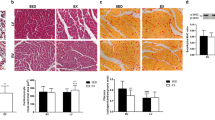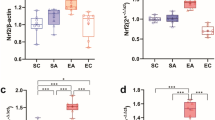Abstract
Purpose
The real mechanisms of intensive exercise training-induced energy efficiency have not yet been well examined. Therefore, the aim of the present study was to investigate the effects of sprint interval training (SIT) on gene expression of uncoupling proteins (UCPs) and endothelial nitric oxide synthase (eNOS).
Methods
For this purpose, 16 Albino Wistar rats (250–300 g) were randomly divided into equal groups of control and sprint training. The animals run on treadmill for 10 weeks, 5 days per week at intensity corresponding to 90–95% maximal oxygen consumption. The gene expression of UCP2, UCP3 and eNOS was analyzed by RT-PCR method in hearts. The data were analyzed by independent samples T test at P < 0.05 level.
Results
Sprint interval training significantly decreased mRNA expression of UCP2 (t14 = 4.818, P = 0.001) and UCP3 (t14 = 4.620, P = 0.001) in cardiac muscle of rats. In contrast, mRNA expression of eNOS in cardiac muscle significantly increased following sprint interval training (t14 = 7.967, P = 0.001).
Conclusion
This study elucidates that SIT through reduction in gene expression of uncoupling proteins can improve energy efficiency. But, more studies are needed to confirm this hypothesis.


Similar content being viewed by others
Abbreviations
- C:
-
Control
- eNOS:
-
Endothelial nitric oxide synthase
- SIT:
-
Sprint interval training
- UCPs:
-
Uncoupling proteins
- VO2max:
-
Maximal oxygen uptake
References
Fernström M, Tonkonogi M, Sahlin K (2004) Effects of acute and chronic endurance exercise on mitochondrial uncoupling in human skeletal muscle. J Physiol 554(3):755–763
Rolfe DF, Brand MD (1996) Contribution of mitochondrial proton leak to skeletal muscle respiration and to standard metabolic rate. Am J Physiol Cell Physiol 271(4):C1380–C1389
Fallahi AA, Shekarfroush S, Rahimi M, Jalali A, Khoshbaten A (2016) Alteration in cardiac uncoupling proteins and eNOS gene expression following high-intensity interval training in favor of increasing mechanical efficiency. Iran J Basic Med Sci 19(3):258
Echtay KS, Roussel D, St-Pierre J, Jekabsons MB, Cadenas S, Stuart JA, Harper JA, Roebuck SJ, Morrison A, Pickering S, Clapham JC (2002) Superoxide activates mitochondrial uncoupling proteins. Nature 415(6867):96–99
Sun X, Wray C, Tian X, Hasselgren PO, Lu J (2003) Expression of uncoupling protein 3 is upregulated in skeletal muscle during sepsis. Am J Physiol Endocrinol Metab 285(3):E512–E520
Bo H, Jiang N, Ma G, Qu J, Zhang G, Cao D, Wen L, Liu S, Ji LL, Zhang Y (2008) Regulation of mitochondrial uncoupling respiration during exercise in rat heart: role of reactive oxygen species (ROS) and uncoupling protein 2. Free Radic Biol Med 44(7):1373–1381
Dhamrait SS, Williams AG, Day SH, Skipworth J, Payne JR, Humphries SE, Montgomery HE (2012) Variation in the uncoupling protein 2 and 3 genes and human performance. J Appl Physiol 112(7):1122–7
Tonkonogi M, Krook A, Walsh B, Sahlin K (2000) Endurance training increases stimulation of uncoupling of skeletal muscle mitochondria in humans by non-esterified fatty acids: an uncoupling-protein-mediated effect? Biochem J 351(3):805–810
Schrauwen P, Hesselink M (2003) Uncoupling protein 3 and physical activity: the role of uncoupling protein 3 in energy metabolism revisited. Proc Nutr Soc 62(3):635–643
Schrauwen P, Troost FJ, Xia J, Ravussin E, Saris WH (1999) Skeletal muscle UCP2 and UCP3 expression in trained and untrained male subjects. Int J Obes 23(9):966–972
Luo S, Lei H, Qin H, Xia Y (2014) Molecular mechanisms of endothelial NO synthase uncoupling. Curr Pharm Des 20(22):3548–3553
Balligand JL, Feron O, Dessy C (2009) eNOS activation by physical forces: from short-term regulation of contraction to chronic remodeling of cardiovascular tissues. Physiol Rev 89(2)(1):481–534
Lee-Young RS, Ayala JE, Hunley CF, James FD, Bracy DP, Kang L, Wasserman DH (2010) Endothelial nitric oxide synthase is central to skeletal muscle metabolic regulation and enzymatic signaling during exercise in vivo. Am J Physiol Regul Integr Comp Physiol 298(5):R1399–R1408
Farah C, Kleindienst A, Bolea G, Meyer G, Gayrard S, Geny B, Obert P, Cazorla O, Tanguy S, Reboul C (2013) Exercise-induced cardioprotection: a role for eNOS uncoupling and NO metabolites. Basic Res Cardiol 108(6):389
Boss O, Samec S, Desplanches D, Mayet MH, Seydoux J, Muzzin P, Giacobino JP (1998) Effect of endurance training on mRNA expression of uncoupling proteins 1, 2, and 3 in the rat. FASEB J 12(3):335–339
Russell AP1, Somm E, Praz M, Crettenand A, Hartley O, Melotti A, Giacobino JP, Muzzin P, Gobelet C, Dériaz O (2003) UCP3 protein regulation in human skeletal muscle fibre types I, IIa and IIx is dependent on exercise intensity. J Physiol 550(Pt 3):855–861 (Epub 2003 Jun 6)
Hjeltnes N, Fernström M, Zierath JR, Krook A (1999) Regulation of UCP2 and UCP3 by muscle disuse and physical activity in tetraplegic subjects. Diabetologia 42(7):826–830
Liu WY, He W, Li H (2013) Exhaustive training increases uncoupling protein 2 expression and decreases Bcl-2/Bax ratio in rat skeletal muscle. Oxid Med Cell Longev 780719:1–7
Jones TE, Baar K, Ojuka E, Chen M, Holloszy JO (2003) Exercise induces an increase in muscle UCP3 as a component of the increase in mitochondrial biogenesis. Am J Physiol Endocrinol Metab 284(1):E96–E101
Ascensão A, Magalhães J, Soares JM, Ferreira R, Neuparth MJ, Marques F, Oliveira PJ, Duarte JA (2006) Endurance training limits the functional alterations of heart rat mitochondria submitted to in vitro anoxia-reoxygenation. Int J Cardiol 109(2):169–178
Fenning A, Harrison G, Dwyer D, Rose’Meyer R, Brown L (2003) Cardiac adaptation to endurance exercise in rats. Mol Cell Biochem 251(1):51–59
TaheriChadorneshin H, Cheragh-Birjandi S, Ramezani S, Abtahi-Eivary SH (2017) Comparing sprint and endurance training on anxiety, depression and its relation with brain-derived neurotrophic factor in rats. Behav Brain Res 329:1–5
Young CG, Knight CA, Vickers KC, Westbrook D, Madamanchi NR, Runge MS, Ischiropoulos H, Ballinger SW (2005) Differential effects of exercise on aortic mitochondria. Am J Physiol Heart Circ Physiol 288(4):H1683–H1689
Judge S, Jang YM, Smith A, Selman C, Phillips T, Speakman JR, Hagen T, Leeuwenburgh C (2005) Exercise by lifelong voluntary wheel running reduces subsarcolemmal and interfibrillar mitochondrial hydrogen peroxide production in the heart. Am J Physiol Regul Integr Comp Physiol 289(6):R1564–R1572
Kim DH, Kim SH, Kim WH, Moon CR (2013 Dec) The effects of treadmill exercise on expression of UCP-2 of brown adipose tissue and TNF-α of soleus muscle in obese Zucker rats. J Exer Nutr Biochem 17(4):199
Oh KS, Kim EY, Yoon M, Lee CM (2007) Swim training improves leptin receptor deficiency-induced obesity and lipid disorder by activating uncoupling proteins. Exp Mol Med 39(3):385
Yang L, Jia Z, Zhu M, Zhang J, Liu J, Wu P et al (2014) Exercise protects against chronic beta-adrenergic remodeling of the heart by activation of endothelial nitric oxide synthase. PLoS One 9:e96892
Calvert JW, Condit ME, Aragon JP, Nicholson CK, Moody BF, Hood RL, Sindler A, Gundewar S, Seals DR, Barouch LA, Lefer DJ (2011) Exercise protects against myocardial ischemia-reperfusion injury via stimulation of beta(3)-adrenergic receptors and increased nitric oxide signaling: role of nitrite and nitrosothiols. Circ Res 108:1448–1458
Holloway TM, Bloemberg D, da Silva ML, Simpson JA, Quadrilatero J, Spriet LL (2015) High intensity interval and endurance training have opposing effects on markers of heart failure and cardiac remodeling in hypertensive rats. PLoS One 10:e0121138
Ma ZY, Zhao YC (2014) Effects of aerobic exercise training on antihypertension and expressions of VEGF, eNOS of skeletal muscle in spontaneous hypertensive rats. Zhongguo ying yong sheng li xue za zhi = Zhongguo yingyong shenglixue zazhi = Chin J Appl Physiol 30(4):320–324
Derdak Z, Garcia TA, Baffy G (2009) Detection of uncoupling protein-2 (UCP2) as a mitochondrial modulator of apoptosis, 2nd edn. In: Erhardt P, Toth A (eds) Apoptosis: methods and protocols, vol 559. Humana Press. Totowa, NJ, pp 205–217
French JP, Hamilton KL, Quindry JC, Lee Y, Upchurch PA, Powers SK (2008) Exercise-induced protection against myocardial apoptosis and necrosis: MnSOD, calcium-handling proteins, and calpain. FASEB J 22(8):2862–2871
Lennon SL, Quindry JC, Hamilton KL, French JP, Hughes J, Mehta JL, Powers SK (2004) Elevated MnSOD is not required for exercise-induced cardioprotection against myocardial stunning. Am J Physiol Heart Circ Physiol 287(2):H975–H980
Lawler JM, Kwak HB, Kim JH, Suk MH (2009) Exercise training inducibility of MnSOD protein expression and activity is retained while reducing prooxidant signaling in the heart of senescent rats. Am J Physiol Regul Integr Comp Physiol 296(5):R1496–R1502
Corte de Araujo AC, Roschel H, Picanco AR, do Prado DM, Villares SM, de Sa Pinto AL et al (2012) Similar health benefits of endurance and high-intensity interval training in obese children. PloS One 7(8):42747
Acknowledgements
We thank the staff of the animal laboratory at Baqiyatallah University of Medical Sciences for their valuable assistance with us in carrying out the exercise protocols and animal surgery.
Funding
This research received no specific grant from any funding agency in the public, commercial, or not-for-profit sectors.
Author information
Authors and Affiliations
Corresponding author
Ethics declarations
Conflict of interest
The authors declare that they have no conflict of interest.
Ethical approval
All methods performed in the study were in accordance with ethical standards of the national research committee and with the 1964 Helsinki Declaration.
Informed consent
There is no informed consent for this study since the study was not conducted on humans.
Rights and permissions
About this article
Cite this article
TaheriChadorneshin, H., Rostamkhani, F. & Shirvani, H. Long-term effects of sprint interval training on expression of cardiac genes involved in energy efficiency. Sport Sci Health 15, 59–63 (2019). https://doi.org/10.1007/s11332-018-0480-z
Received:
Accepted:
Published:
Issue Date:
DOI: https://doi.org/10.1007/s11332-018-0480-z




